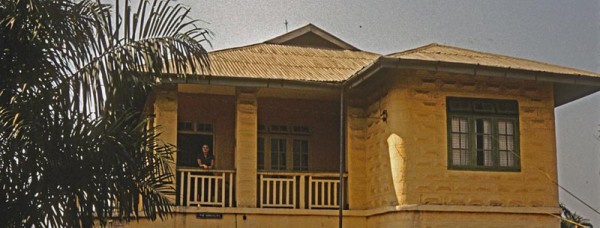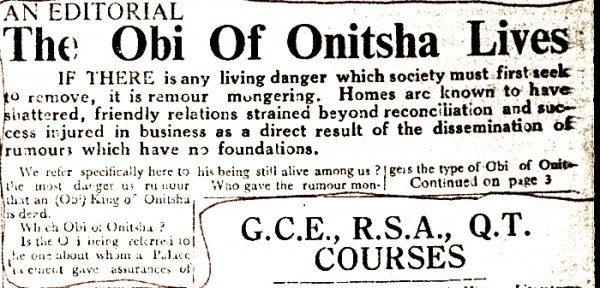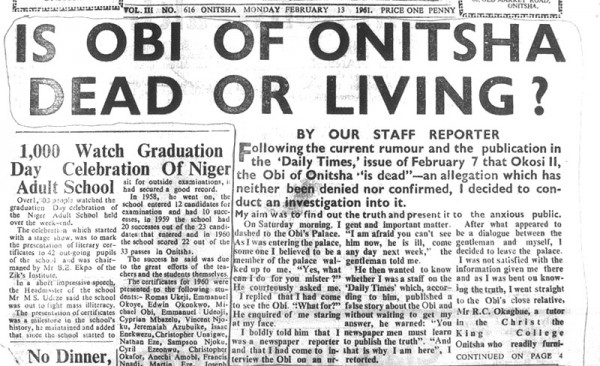Above, Helen on our upstairs balcony 24 Mba Road
[Note: Click on any image you may want to enlarge.]
1. February 2, 1961, 24 Mba Road

Early on this particular afternoon, while Helen and I are working on field notes in our “upstairs” apartment at 24 Mba Road, Onitsha Inland Town, our frequent companion Byron Maduegbuna appears unexpectedly at the door. At our invitation he enters and sits down on one of the padded chairs in our living room, smiling enigmatically at us through his thick glasses. In February of 1961 we have been living in Onitsha for nearly five months, and Byron has become our closest confidant, our reliable interpreter and knowledgeable conductor into the labyrinths of Onitsha culture and society.
For us he has become a major delight, a fairly young man (pushing 30, as am I) who approaches the world with a persistent mixture of trepidation and wry wit and humor that conveys to us not only his deep knowledge of and commitment to Onitsha tradition but also surprising sophistication concerning a range of Western affairs. He also has broad knowledge of communities related to Onitsha, and has escorted us to many significant places outside the town. (At left above, Byron during one of our visits to Nsugbe town in the Fall of 1960.)
He has a library full of serious books that fill a whole wall of his small room at the Maduegbuna home in Onitsha Waterside (a feature we did not see paralleled anywhere else during our two years in Onitsha, though it must be said that we did not spend much time in the homes of Onitsha elites), and he is in some ways a stimulating literary scholar. (He often reminds us that his name is Byron, and that among Onitsha people names are not conferred by casual chance. His grandfather, the late, sixth-senior chief of Onitsha (the Owelle, S.C. Obianwu) gave him as his English name that of the great Romantic poet, sensing a literary bent in the infant Byron.)
On this February second in 1961, Byron sits in unusual silence, though he seems to have something he wants to say. Finally, while drinking from a glass of water (he has observed that beer is inappropriate this afternoon because he has serious work to do), he speaks almost in a whisper, “The iron has broken”. When I ask what he means by this proverb, he replies with another: “A mighty tree has fallen: birds who sheltered in its branches now have no abode”. Glancing at us repeatedly with an air of mystery as he readjusts his glasses to his nose, he concludes that everything has changed — “Onitsha will never be the same after this day”.
Taking the bait, we press Byron to reveal the contents of this mystery. Having first emphasized the need for absolute secrecy in discussing the matter at hand, he then tells us that the King (Obi) of Onitsha, James Okosi (“Okosi II”, called “Sky”, “Great River”, “Deadly Snake”, “Termite Hill,” and “Our Father”, among other formal salutation labels, by his loyal subjects) has died suddenly this very morning in the confines of his palace (Ime-Obi) on Okosi Road in Onitsha “Inland Town” (Enu-onicha, “High Onitsha”, the indigenous, gardened villages located on forested hills above the River Niger, now almost surrounded by the urban sprawl of Onitsha Waterside (Otu-Onicha). Byron adds that rumors are already spreading about likely candidates for succession to the throne, but when we ask him to tell us more about these he says such talk is premature, it must await the completion of the Obi‘s final Ofala, his annual festive harvest-season Emergence (which also has the yearly meaning of, and will now be rescheduled out of season as, his funeral). Until the formal public announcement of that time, Byron insists, the Obi must be regarded as still living among us, and issues of succession therefore simply do not arise.
He then departs from our house saying he has some very pressing errands to do (carrying, as usual for him, a sheaf of papers in a manila packet under his arm), leaving us feeling shocked, excited, and very privileged to have become anthropologist parties to this portentous secret moment being shared among Onitsha people (ndi-Onicha), the ancient occupants of this entire urban zone (and now the self-defensive denizens of its upper, Inland Town, surrounded by a sea of outsiders).
As our second official guide in Onitsha, Byron has already opened so many social doors for us that we live in what seems like perpetually heightened awareness, frequently visited by or visiting people from worlds so new to us that we have found almost no time to process each daily adventure before another one unfolds afresh. And with Byron each incident promises others, for nearly everyone we meet in his company appears not only to give a degree of trust to him but also (and therefore) to us as well, and this sharply contrasts with our initial experience with some of our previous Onitsha guides.
For example, early in our stay when we are casting about for research assistants, one man in his fifties, Ozo-titled (I will call him Ozodiegwu) and therefore formally appropriate for dealing with the varieties of superior people we are likely to want to visit, assured me that “Mr. Henderson, I am for you!”, but used us relentlessly and repeatedly for his own personal agendas, for example escorting us to Onitsha General Hospital, ostensibly to introduce us to an important Onitsha doctor there, but having briefly presented us to the man, he dragged his own wife into the room ahead of a very long line of waiting patients and told the doctor that we wanted him to give her a quick medical examination. (We exchanged embarrassed looks with the doctor, who obviously saw through the charade but dealt with it in a dignified way.) Ozodiegwu‘s behavior had a blatantly self-seeking quality that disturbed us, and it included subtly seeking to pry out of our hands wealth we did not have.
As we began to wonder if such propensities might be found frequently among Onitsha men, other new acquaintances visited us and in passing expressed the concern that we were being introduced to Onitsha people by the “wrong kind of person”. Ozodiegwu himself was a member of an influential family, but several of his own elder relatives soon came to us, warned us of the danger of associating with a Wrong Person, and recommended that we should find someone more popular among the wider community — Byron Maduegbuna, for example, of Isiokwe Village, who was well-regarded nearly everywhere. We were in fact rescued from our own folly about a month after our arrival, and Byron became our regular escort due to no self-sufficient efforts on our part but by what we would today call an “intervention” by social-psychologically more sophisticated parties than were we. (Quite a number of Ndi-Onicha were significantly better educated and more urban-sophisticated than ourselves.)
Thus it transpires that Byron draws us into his own family/village of Isiokwe (ideologically constituted as a patrilineal descent group). Isiokwe quasi-membership becomes of great personal significance to us, since inclusion into this kinship-bonded domain gives us entry into a world of open-hearted expressiveness by many people of different ages, a process which considerably transforms our own emotional lives (especially mine, which had through years of academia become something approximating what the late Stanley Diamond identified as a “dissociated man”1). Byron introduces us as well to numerous people from other Onitsha villages and from widely differing social categories, always seeking to expose us to a wide range of “the right people” (meaning those generally regarded as thoughtful, socially responsible for their actions, and therefore respectable).
He is a familiar (through his mother, also a widely-respected person) of the great Zik Himself — Nnamdi Azikiwe, an indigenous Onitsha man who pioneered an educational exodus by Africans to the United States in the 1920s, where his training in Anthropology included courses at Howard University, Lincoln University, and the University of Pennsylvania (including work with A.I. Hallowell), culminating in an M.Sc. in Anthropology at Penn with a thesis entitled “Mythology in Onitsha society.”2
Zik became the greatest Igbo-speaking proponent of Nigerian Independence, and he is now (in 1961) Governor-General of the new Nigerian Federation. In light of contacts like this, Byron’s value seems to us limitless, and the fact that he seldom asks anything of us (beyond whatever dubious prestige might accrue to him by presenting American anthropologists to local people) is somewhat unfathomable.3 During our stay, I learn that he has previously escorted political scientist Richard Sklar when the latter briefly visited Onitsha while researching his magisterial book on Nigerian Poliitics during this period.4
Byron and I are not only roughly age-mates (in our late twenties), but are each rather shy, by preference, somewhat retiring (each of us could accurately be described as “bookish”), yet eager to meet with and show respect to those who are knowledgeable and willing to share their knowledge. My wife Helen, with her gently ironic wit and persistent willingness to build conversational relationships with people in general, further bonds us together (and reassurres most Ndi-Onicha of our basic decency as a couple), and the three of us quickly become something of a “team” whose primary goal is to build knowledge about Onitsha.
Byron takes it as his task to find as many anthropologically interesting things for us to do as he can manage while teaching at a local secondary school and juggling his wide portfolio of activities in diverse local affairs. His work includes not only providing us contacts with indigenous Onitsha men and women, but with members of various immigrant communities as well, and he leads us on jaunts to various places in the rural countryside which are as different from the city of Onitsha as night is from day. For more information on him and his family, see this link:
And as we move about Onitsha with Byron, we find that many Onitsha people express excitement, even delight to have American anthropologists among them. As we marvel that this is so, Byron himself explains it, being himself a fairly close relative (through his mother) of the great Zik, the pioneer of American-educated anthropologists. In some sense, then, many knowledgeable Onitsha people see us (by the beginning of 1961, anyway) as one of the apparent fruits of Zik’s earlier Odyssey in the United States– as people who are in some sense following him back to Nigeria to continue some of his own earlier anthropological work.5
So when on February 2 Byron presents this new opening to us, we feel (rather unrealistically) confident that we will be able to observe the now-forthcoming Interregnum as in some sense quasi-members of Onitsha Inland Town. Since his whispering notification has signaled to us an imperative of secrecy, we wonder who the “outsiders” excluded by secrecy might be in this instance. Since Isiokwe Village is part of the Onitsha royal clan (the “Umu-EzeChima“), is the closure against all those categorized as non-royal? Or is it opposed to the Non-Onitsha igbo-speaking (and other non-Ndi-Onicha) immigrants occupying the Waterside?
In fact, by the following morning (February 3), knowledge of the Obi‘s death is nearly universal throughout the ten thousand or so occupants of Onitsha Inland Town, and within two days is common information as well among many if not most of the many tens of thousands of immigrant Ndi-Igbo (Igbo people) living in the Onitsha Waterside. We find that many Onitsha Indigenes show little hesitation to speak openly and frankly about the subject (even to outsiders of very brief acquaintance), once they have verbalized the convention that only they have the right to open the discourse (by making a statement affirming the requisite of indirection), and as long as standards of discretion are observed.
So “secrecy” is a bracketing convention that does not preclude wide and even detailed discussion of the topic, but merely subjects such talk to a formal process of social control. The boundaries between “insiders” and “outsiders” concern more about one’s position in relation to who has a right to say what, where, and to whom, than an absolute difference between one’s having or not having knowledge about a situation. We know we can talk openly among Ndi-Onicha, but with them in the presence of other outsiders, we will wait and follow the Onitsha line.
2. The traditional requirement of gradual dying
From our previous five months’ fieldwork in Onitsha, we already knew that the obligatory fiction — that a dead king remains living — is only an elaboration of traditional Onitsha funerary customs. These require that members of the patrilineal descent group of any newly deceased person first make a series of visits to various (increasingly distantly-related) parties, notifying them that the deceased is suffering an illness (Oya), then repeat the visit to announce that the illness has become “serious”, and finally performing a third visit to proclaim that the individual has died and to announce the time and place of burial. For the deaths of many people, this three-step set of ritual announcements might be accomplished on the very same day.
However, “burial” (ini ozu) is but the first of a two-stage funerary process for Onitsha people, in which the second part (“Lamentation”, ikwa ozu), which includes a symbolic “second burial”, requires for important people a time of weeks, months, or more to prepare and may eventually involve nearly the entire community’s participation.6 For the Obi, funerary procedures have been both elaborated and transformed (“since time immemorial”), because his traditional Installation includes enacting the equivalent of his own funerary Lamentation.
The ritual notification of his “illness” had expanded into an elaborate series of stages requiring at least a month (and possibly considerably more), during which all segments of Onitsha society and leaders of some nearby affiliated towns must be consulted and invited to participate in a complex of rituals reaffirming the process of his annual ceremonial “funeral/emergence” while consigning the king’s body to the Mother Earth. 7 The death of Obi Anazonwu in 1899 was apparently not announced for a full year,8 but this may have been an exceptional circumstance related to the disorders surrounding shifts of colonial as well as indigenous powers.
The same may be true of the delay following Obi Okosi I’s demise in 1931 (see further below). Until the stage for this combined burial and “Emergence” has been formally constructed, the corpse must be covertly preserved while maintaining the fiction of his continuing life.
People tell us that, in the old days, within the confines of the palace the royal patrilineage Daughters (umu-ada) began the task of preserving the Obi‘s body for its final display by first smearing the skin with a mixture of red ochre, tobacco juice, and a spice of dried fruit, then wrapping the corpse tightly with cloth. The lineage Youths (umu-ilo) dug into the earthen floor of the palace near the king’s throne a rectangular hole large enough to accommodate the extended body, and constructed a wooden rack over it. After being wrapped in palm fibre matting, the body was placed on this rack and a mixture of oils and tobacco juice poured over it. Wood and dried animal bones were set afire in the bottom of the pit, and the patrilineage Daughters supervised the slow process of drying and smoking the remains. We were also told that a ritual procedure of this kind had been followed for about 9 months over the corpse of Obi Samuel Okosi I after his death in 1931 (prior to the announcement of his death)9
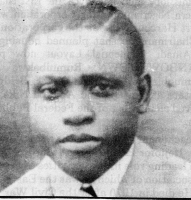
But now, we are told, Okosi II is being secretly embalmed in the local hospital of Dr. J.O. Onyeachonam, a prominent son of the Obi‘s sub-clan who has become the first Onitsha man to establish a private hospital possessing this kind of Western mortuary equipment (and where the operations may also be performed in a context of relative secrecy).
From the first days after Obi Okosi II’s death in 1961, the idealized “custom” of the past is subjected to new social and cultural contexts: the pace of life in Onitsha has greatly accelerated, and its arenas of social reference have expanded considerably since the funeral of his father in 1931, and while the responsible elders making the funerary arrangements aim toward a secrecy interval of about a month, even this minimal duration of fictional vitality is likely to be disregarded by many. Subsequent events make us wonder why most elders emphasize the need for such an elaborate complex of fiction and secrecy, while others seem bent on accelerating public awareness of the process.
3. Ritual secrecy and the Nigerian Press
On February 7, the Daily Times, a newspaper of national readership published and distributed from the Nigerian capital city of Lagos, ignores the Onitsha indigenes’ rule of ritual secrecy by printing a report openly speculating that the King of Onitsha is dead. Back in Onitsha, the Nigerian Spokesman, the dominant local daily newspaper (established in the early 1940s by Zik), immediately rebuts this report on February 8 with a front page headline:10
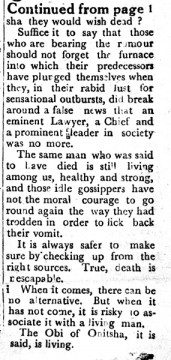 By this time we have some familiarity with the Nigerian Spokesman‘s literary style, and are in some measure accustomed to its editorial means of communicating powerful socio-poliltical emotions by means of formally controlled but often sarcastic statements. The headline of the editorial is quite unambigous but reads like a slogan. The textual references to personal agency are indefinite, the moralizing ponderously matter-of-fact, quasi-scientific. But within this rather impersonal framework, some very strong messages are conveyed.
By this time we have some familiarity with the Nigerian Spokesman‘s literary style, and are in some measure accustomed to its editorial means of communicating powerful socio-poliltical emotions by means of formally controlled but often sarcastic statements. The headline of the editorial is quite unambigous but reads like a slogan. The textual references to personal agency are indefinite, the moralizing ponderously matter-of-fact, quasi-scientific. But within this rather impersonal framework, some very strong messages are conveyed.
First, the editorial points a finger at certain enemies who might wish the Onitsha king dead. An oblique reference to a previous (and false) rumor alludes to the ongoing intensity of political struggle against an indefinite enemy (an incident in which agents of the latter had spread a false story about a prominent politician). Second, it metaphorically links the unnamed agents of the “rumour-mongering” with vile dogs (rabidness, licking back one’s vomit), and envisions their falling into an inferno. Finally, the headline’s factuality is qualified by an informational passivity concerning the Obi’s condition: “it is said” that the Obi is alive, thus affirming the relevance of the formal ritual norm of secrecy to the mass media context. Thus the editorial clearly identifies social norms appropriate to the situation (those of censorship) and backs their legitimacy with a violence-imaging threat.
A second local newspaper published in Onitsha in 1961, the Eastern Observer, is allied to the Daily Times of Lagos (and with the Yoruba-connected national party called the Action Group), and its “Staff Reporter” grasps the issue in a subsequent article which appears under a more wide-eyed headline on February 13:
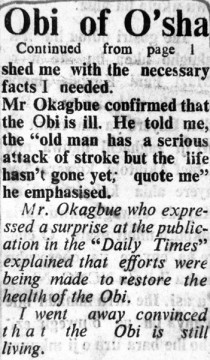 In striking contrast to its Spokesman counterpart, this personal-adventure narrative is witty, its ironic register (“…what appeared to be a dialogue between the gentleman and myself…” etc.) strongly distancing the reporter from the traditional moral frameworks of the Onitsha palace and identifying him as a sophisticated contemporary person (one whose orientation primarily concerns current factual issues of national significance rather than esoterica of the pre-modern past, toward which a rather ironic attitude is appropriate). At the same time it manages, by means of its verbatim dialogue, to suggest that boundaries of truth and fiction are indeed being blurred at the palace, while bowing nicely (in its rather non-sequitur concluding sentence) to the Spokesman’s editorially menacing demand for adherence to the secrecy code.
In striking contrast to its Spokesman counterpart, this personal-adventure narrative is witty, its ironic register (“…what appeared to be a dialogue between the gentleman and myself…” etc.) strongly distancing the reporter from the traditional moral frameworks of the Onitsha palace and identifying him as a sophisticated contemporary person (one whose orientation primarily concerns current factual issues of national significance rather than esoterica of the pre-modern past, toward which a rather ironic attitude is appropriate). At the same time it manages, by means of its verbatim dialogue, to suggest that boundaries of truth and fiction are indeed being blurred at the palace, while bowing nicely (in its rather non-sequitur concluding sentence) to the Spokesman’s editorially menacing demand for adherence to the secrecy code.
This interchange, which demonstrates that the Onitsha “game” of appropriate secrecy has national implications as well as purely local ones, nicely illustrates one of many contrasting positions taken by the Observer and the Spokesman in the social and political life of Eastern Nigeria in 1961. These two newspapers both reflect and enact contemporary politics from local through regional to national and even international levels, their oppositions emerging from historical and cultural as well as economic and political contexts which must be grasped to some extent if we hope to discern their operation in the local scene. For a brief outline of these contexts, see this side-page:
Nnamdi Azikiwe and Nigerian Press Politics
4. Some Meanings of “The Obi Lives”
So this initial duet of editorials reflects much larger issues than the immediate question of whether Obi Okosi II is alive or dead. Viewed in light of local, regional, and national politics, the February 1961 controversy between the Nigerian Spokesman and the Eastern Observer points to a complex interplay of diverging interests. The Spokesman editorial, “The Obi Lives”, embodying the official, national-governing-party establishment line (and framing this as a kind of “objective truth”), demands conformity to the traditionalist constructions it seeks to purvey as an agent of national power – “instituted authority, including that of traditional rulers, must be respected”. The Observer, as a messenger of politically counter-hegemonic perspectives (a radically socialist, avowedly egalitarian view), must proceed with considerable care in an Eastern Region controlled by its national opponents, but convey such oppositional views it also must (if its presence in the community is to have political value). That the oppositional voice is self-consciously “modern” (without labeling itself as such) is consistent with the new and radical “democratic socialist” policies of the Action Group, while the Spokesman in contrast wraps itself in a cloak of time-honored authority (which can now become balefully threatening, because it is power-backed by the NCNC’s dominance in an existing National regime whose Northern leaders are markedly authoritarian). In local terms, the contrast drawn is that between the Onitsha indigenes, with their King, and the Ndi-Igbo immigrants, who “lack real Kingship”, and who for some time have openly proclaimed themselves “Non-Onitsha Ibos”.
- Diamond 1963: [↩]
- See Azikiwe 1970:116-160 for his own summary of this aspect of his career. [↩]
- In retrospect of many years, I am sure one of his jobs was to inform Zik and other Ndi-Onicha about the intentions of these two curious, intrusive foreigners, and I don’t doubt that he regaled many people with stories of our often blundering but what he saw as well-intentioned behavior. [↩]
- See Sklar 1963. [↩]
- Zik himself felt plenty of ambivalence toward Americans, especially white Americans. When Byron introduced me to him in the dark lower chamber of Maduegbuna household one day, he was distinctly cool and distant. But by that time, he was enmeshed in the depressively paranoid political context that was contemporary Nigeria, so I should hardly have expected otherwise. [↩]
- Henderson, Helen 1969 provides detailed descriptions of Onitsha funerals. For briefer accounts, see Meek (1937:188-89), and Henderson (1972, use index headings “Funeral” and “Lamentation”. [↩]
- Earliest historical references to a particular application of the custom date from 1872, when Obi Akazua died, and say that “his body was concealed for about seven of their (i.e., Onitsha indigenes’) weeks… according to custom.” The reporting missionaries thought this would amount to 21 days, but an Onitsha traditional week constitutes 4 days. See Crowther, Samuel A., 1873:47-48; Romaine, W., 1873:230-31. [↩]
- See Basden 1938:277 [↩]
- The period is confirmed by other sources (e.g. Onitsha Province Annual Report 1931), but while an explanation for the delay is proferred there which points to the impact of colonial conditions, the details of how the corpse was treated are unclear. [↩]
- Nigerian Spokesman February 8, 1961. [↩]
